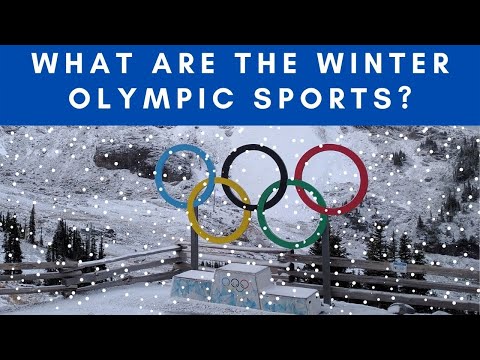What Are All the Winter Olympic Sports?
Contents
The 2018 Winter Olympics are just around the corner, and we can’t wait to see all the amazing athletes competing in all the different sports! But what exactly are all the sports that will be featured in this year’s Winter Olympics? Here’s a complete list of all the sports that will be included in the 2018 Winter Olympics in PyeongChang, South Korea.
Checkout this video:
Figure Skating
Figure skating is a sport in which skaters use ice skates to glide across the ice and perform various jumps, spins, and other complicated maneuvers. It is a popular sport in the Winter Olympics.
Pairs Skating
Pairs skating is a discipline of figure skating in which two skaters, one man and one woman, skate together. It is similar to ice dancing, but there are some differences. In pairs skating, the man and woman perform jumps, lifts, spins and other moves together. The pairs skating program includes a short program and a free skating program. Skaters must perform jumps and throws in the short program and are allowed to do more complicated lifts, jumps and throws in the free skating program.
Pairs skating was first included in the Olympic Winter Games in 1924. At that time, only eight pairs competed. The event has been held at every Olympic Winter Games since 1952.
The International Skating Union (ISU) is the international governing body for figure skating. The ISU sets the rules for pairs skating and determines which skaters will compete at the Olympic Winter Games. To be eligible to compete at the Olympic Winter Games, skaters must meet certain eligibility requirements set by the ISU.
Ice Dancing
Ice dancing is a discipline of figure skating that draws from ballroom dancing. It is characterized by intricate footwork and close partnership between the man and the woman skating together. Couples must skate to music with a defined beat, performing synchronized turns and lifts. Unlike in pairs skating, lifts in ice dancing are not limited to those that start and end with the skaters on the ice.
The first world championship for ice dancing was held in 1952, but it was not until 1976 that ice dancing became a medal sport at the Winter Olympics. The United States has been dominant in Olympic ice dancing, winning 14 of the 26 medals that have been awarded.
Skiing
Skiing is a winter Olympic sport that can be traced back to Norway in the late 1800s. It was included in the first Winter Olympics in 1924. There are several types of skiing, including alpine, cross-country, freestyle, and Nordic.
Alpine Skiing
Alpine skiing, also commonly known as downhill skiing, is the most widespread type of skiing. It is characterized by skiing down a sloped hill, either natural or man-made. There are different types of alpine skiing, including:
-Slalom
-Giant slalom
-Super giant slalom
-Downhill
Cross-Country Skiing
Cross-country skiing is a form of skiing where skiers rely on their own locomotion to move across snow-covered terrain, rather than using ski lifts or other forms of assistance. Cross-country skiing is widely practiced as a sport and recreational activity; however, some still use it as a means of transportation.
The word “ski” is believed to have its origins in the Old Norse word “skíð” which means “a piece of wood” or “splinter.” This makes sense given that early skis were nothing more than long pieces of wood that were used for transportation during the winter months. Cross-country skiing can be traced back to Scandinavia where it was used as a means of efficient travel in wintertime.
Freestyle Skiing
Freestyle skiing is a term used to describe a number of different ski events. The main difference between freestyle and alpine skiing is that in freestyle, skiers can use the entire slope, including jumping and performing acrobatic maneuvers.
mogul – A type of freestyle skiing that is contested on a course with moguls, or bumps. Mogul courses are short, requiring skiers to make quick turns around the bumps.
aerials – A type of skiing in which skiers perform flips and twists off of jumps. Skiers are judged on their overall performance, including the height and difficulty of their jumps, as well as their landing.
ski cross – A type of skiing in which four skiers race down a course at the same time, with the first one across the finish line winning. Ski cross courses typically include a mix of terrain, including moguls, rollers, and jumps.
Nordic Combined
Nordic combined is one of the most unique events in the Winter Olympics. It’s a two-day event that combines both cross-country skiing and ski jumping. The first day consists of a ski jumping event, and the second day is a cross-country skiing Race.
The ski jumping portion of the event is held on a large hill, where athletes attempt to jump as far as possible. The distance they jump is then converted into points, which are used to determine their start order for the cross-country race.
The cross-country race is held on a designated course, with athletes Start at different intervals based on their point totals from the ski jump. The first person to cross the finish line wins the event.
Nordic combined was first included in the Olympics in 1924, and has been held at every Winter Games since then except for 1952. It’s considered one of the most challenging events in the Olympics, as athletes must be proficient in both Skiing and Ski Jumping.
Ski Jumping
The origins of ski jumping date back to Norway in the late 1800s, when Ole Rye and Sondre Norheim began experimenting with different ways to launch themselves off natural ramps and land on soft snow. Today, ski jumpers use specially designed skis, boots and suits to glide down a long, steep ramp and soar into the air. They earn points for both the length and style of their jumps.
Snowboarding
Snowboarding is one of the most popular sports in the Winter Olympics. It first became a medal sport in 1998 and has been in every Winter Olympics since then. Snowboarding is a very popular winter activity, and many people enjoy watching it in the Olympics.
Big Air Snowboarding
Snowboarding made its Olympic debut at the 1998 Winter Games in Nagano, and has been a mainstay of the Winter Olympics ever since. Big air snowboarding made its debut at the 2018 Winter Olympics in Pyeongchang.
As the name suggests, big air snowboarding is all about going big! Riders attempt to impress the judges with their biggest and best tricks as they soar off a massive jump. The jumps are usually between 20 and 30 feet, and riders can reach speeds of up to 60 miles per hour!
Halfpipe Snowboarding
One of the most popular events at the Winter Olympics, halfpipe snowboarding, made its debut at the Nagano Games in 1998. In this event, riders strap on their snowboards and attempt to do tricks while going from one side of the halfpipe to the other. The tricks are scored based on difficulty, style and amplitude — how high the rider gets off of the lip of the pipe.
Parallel Giant Slalom Snowboarding
Parallel giant slalom made its Olympic debut at the 1998 Nagano Games. The event tests riders’ speed and carving skills as they navigate around a series of gates on parallel courses.
In the qualification round, all athletes attempt two runs down the course. The top 32 men and 16 women based on their combined time advance to the knockout rounds, where they compete in head-to-head heats. In each head-to-head heat, the rider with the fastest time advances to the next round, until only two athletes remain. The athlete with the fastest time in the final round wins the gold medal.
Snowboard Cross
Snowboard cross, also known as boardercross, is a winter sport featured in the Winter Olympic Games that involves four to six competitors racing down a course similar to a downhill ski course, with jumps, rolls, and banking turns.







